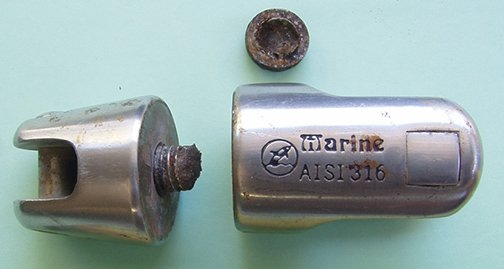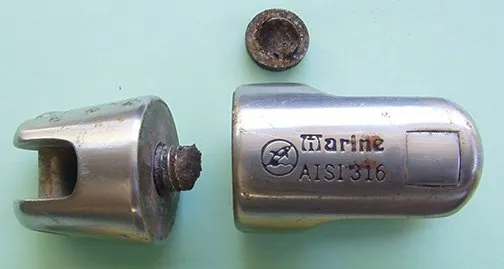
An important question that comes up in our upcoming report on stainless-steel swivels for anchors is where the shackle should be introduced to the rode. A common approach is to attach the swivel at the end of the chain rode directly to the anchor, in lieu of a common anchor shackle.
The trouble with the direct-chain-to-anchor connection is that modern anchors are capable of holding under very high loads, and they don’t readily rotate when the direction of the load changes (as a result of a sudden wind shift, for example). Should this occur, the swivel is then loaded from the side, where it is not as strong.
In the most common type of anchor swivel, sometimes called a barrel swivel, the swivel is quite long, so that the machined-fork that attaches to the anchor acts as a lever, amplifying any side load. When the angle of pull is acute, the fork in the swivel can pry open and the clevis pin or sex-bolt on the end of the fork eventually fails. Sometimes, the swivel just bends, but since stainless steel is not a very ductile metal, it can’t simply be bent back into shape. It must be replaced.
Even the makers of shackles and anchors are divided on where the swivel should go. Kong recommends attaching the anchor swivel to the rode, then, instead of going directly to the anchor, the swivel is attached to a short length of chain (a few links is sufficient), which then leads to the anchor where it is attached with a shackle. Kong doesn’t explicitly caution against attaching the swivel directly to the anchor, and many people still make the connection in this manner.
Introducing a short length of chain into the junction helps diminish any extreme side loading, allowing more articulation where the swivel meets the chain or shackle on the anchor side. Simply putting a shackle between the anchor and the swivel can also allow more freedom of movement.
Other swivel makers say introducing a chain or shackle is unnecessary. Quickline, the U.S. distributor of the Ultra Flip Swivel, recommends attaching the swivel directly to the anchor. They say its swivels-carefully machined and polished ball-and-socket-type swivel-are tested for side-loading and are engineered so the chain will break before the swivel fails, even when loaded from the side.
This raises an important point. If you are considering an anchor swivel, you should focus only on companies who readily share or publish the breaking strength of the swivel when it is loaded from the side, not just a direct, straight pull.
For us, the discussion is purely academic. We, like some of the anchor makers we spoke with, are simply not fans of anchor swivels. The material is also a problem for us: we are averse to having anything made of stainless steel in the rode. For more on this topic, see the September issue of Practical Sailor, which will be available online and in print in mid-August.


































